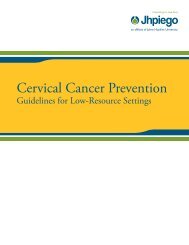Manual for Male Circumcision under Local Anaesthesia
Manual for Male Circumcision under Local Anaesthesia
Manual for Male Circumcision under Local Anaesthesia
You also want an ePaper? Increase the reach of your titles
YUMPU automatically turns print PDFs into web optimized ePapers that Google loves.
<strong>Male</strong> circumcision <strong>under</strong> local anaesthesia<br />
Version 3.1 (Dec09)<br />
the transfer time is likely to be long, insert a urinary catheter, wrap<br />
the penis in sterile gauze, and tape the gauze in place. During the<br />
transfer, the client should lie flat. At all times, the client and his<br />
relatives should be kept in<strong>for</strong>med about what has happened and<br />
what is going to be done. The risk of such accidents is reduced if<br />
the surgeon has received proper training and certification, and if<br />
there is a system of ongoing appraisal and recertification. Risks<br />
are higher if the surgeon becomes overconfident, or when<br />
timetable constraints result in operations being done in a hurry. To<br />
avoid this, countries need to have established and well-funded<br />
training and recertification procedures, and clinics need to ensure<br />
that adequate time is allowed <strong>for</strong> surgery.<br />
• Severing of the glans. If part or all of the glans has been<br />
severed, it should be wrapped in a sterile paraffin gauze to prevent<br />
drying and placed in a polyethylene bag. The man and his glans<br />
should be transferred as soon as possible to a referral centre,<br />
where it may be possible to reattach the glans.<br />
Complications occurring within the first 48 hours after surgery<br />
• Bleeding is the most likely complication during the first 24–48<br />
hours. A small amount of bleeding onto the gauze dressings is<br />
usual, but may alarm the client. If he comes back to the clinic with<br />
blood-soaked dressings, these should be removed and the<br />
circumcision wound inspected <strong>for</strong> an obvious bleeding point. If<br />
there is fresh blood from the skin edge, a further suture should be<br />
inserted. This will require a full sterile procedure, as <strong>for</strong> the original<br />
circumcision, including local anaesthesia and sterile draping.<br />
Usually, placing one or two additional mattress sutures over the<br />
area will stop the bleeding.<br />
• Haematoma may <strong>for</strong>m and may be associated with considerable<br />
bruising and skin discoloration. In general, haematomas are best<br />
left alone, unless they are very large or there is continued<br />
bleeding. The choice is between applying a further clean dressing<br />
and reviewing the situation in 24 hours, or applying a clean<br />
dressing and sending the client to a referral centre. If the<br />
circumcision team is relatively inexperienced, it is safer to send the<br />
man to the referral centre.<br />
• Wound disruption is unusual in the first few days, but is<br />
sometimes seen in association with subcutaneous bleeding and<br />
haematoma <strong>for</strong>mation, when the stitches cut out. In this situation<br />
the man should be sent to a referral centre. The specialist at the<br />
referral centre may decide either to suture the wound or to leave it<br />
to heal by secondary intention, depending on the state of the skin<br />
edges. If the disruption occurs within 48 hours of the operation, it<br />
is usually better <strong>for</strong> the clinic surgeon to explore and re-suture the<br />
wound.<br />
Postoperative care and management of complications Chapter 7-7
















